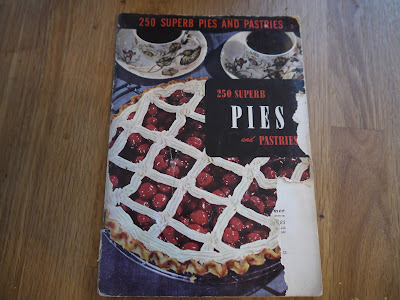What I found was definitely...entertaining. Check out this cheese-based recipe:
Cheese Spears
8 (3/4 inch) cubes of American cheese
8 walnut halves
8 tiny sweet pickles
Spear a cheese cube, a walnut half, then a sweet pickle on an hors d'oeuvre pick. Serve on an hors d'oeuvres holder. Makes 8.
The photo says it all. I speared the cheese, carefully slid the walnut half on the pick, then topped it all off with a sweet pickle. Voila! Honestly, the hardest part of this whole process was keeping the walnut from crumbling apart on the spear.
The snack book listed a variation on this recipe that looked just as easy, so I gave it a shot, too.
Pineapple Spears
Spear a cube of fresh pineapple, then a cube of sharp Cheddar cheese, and top with a cherry.
So easy! And look how festive they are when put all together on the same plate:
They look pretty enough, but you may be wondering how they actually taste. It depends on how you eat them. If you deconstruct the spear, as some of my friends did, then it's just going to taste like each individual ingredient on a stick. Like a '40s shish kabob. But if you eat it all in one bite, that's when things get interesting. Overall, the flavor combo isn't bad. Both have that sweet/savory/tangy medley going on. The strangest thing, though, is the variety of textures. Crunchy, crumbly, juicy, soft--do all of those belong in one bite? I'm not sure.
What I love most about this recipe is that the pineapple and sweet pickles were a surprising nod to Christmases past with my grandmothers. Each year, my Grandma Linda makes the tastiest holiday dishes, but my favorite thing she brings is a big bowl of freshly cut pineapple. It's a sweet and juicy treat reserved for holidays and special occasions. My cousins and I can usually be found hovering near the snack table throughout the day, sneaking pieces of pineapple directly from the bowl. Grandma, if you're reading this, I'm counting on having pineapple again this year at Christmas, hint, hint! I promise not to ruin it by adding cheese and cherries.
For Christmas at my Grandma Pat's house, I could count on finding a triple-decker serving bowl filled, without fail, with potato chips from the local deli, onion dip, and sweet pickles. Who knows what else was served at those holiday dinners--I loaded up on the pickles. It's been 13 Christmases since we lost her to cancer, and the holiday season just isn't the same without her. But having this weird little cheese spear oddly reminded me of her. It's funny how these old recipes can transport us to another time and place, eh?
Merry Christmas and pass the cheese spears!























































